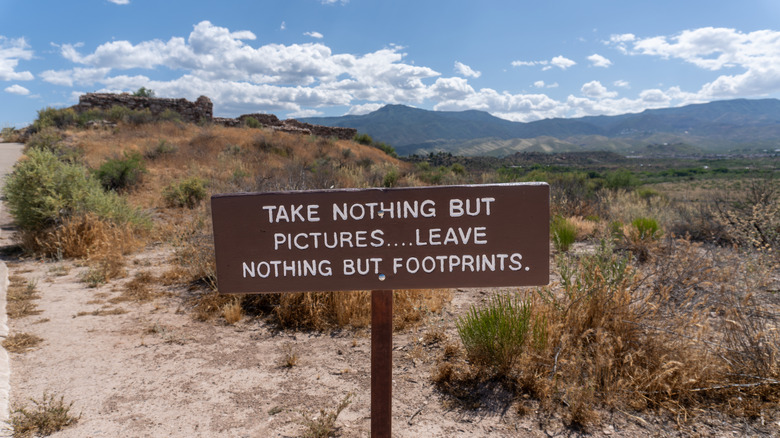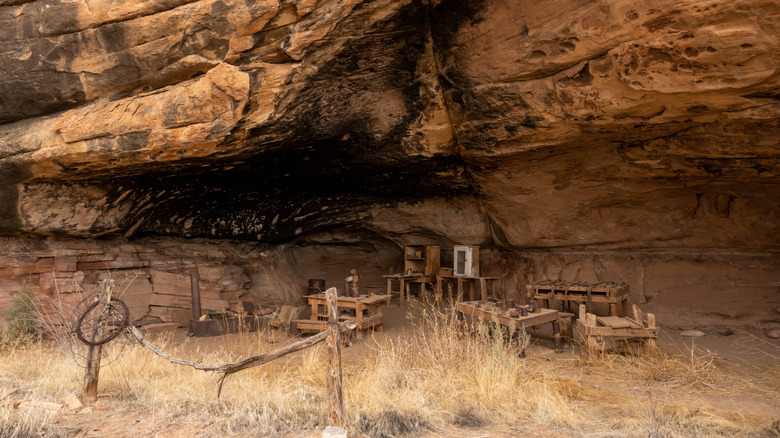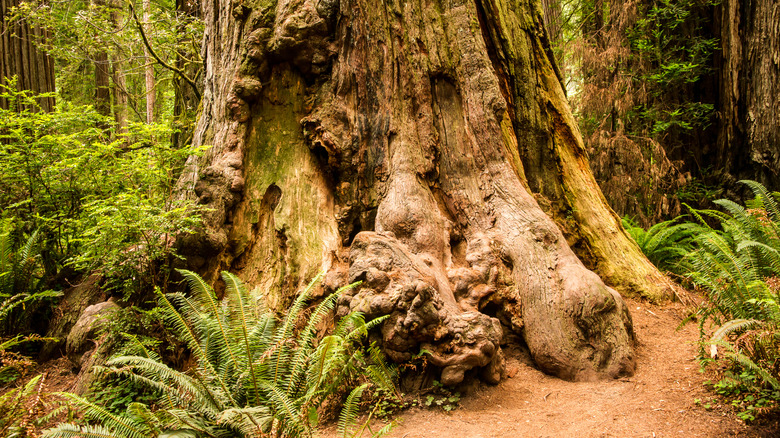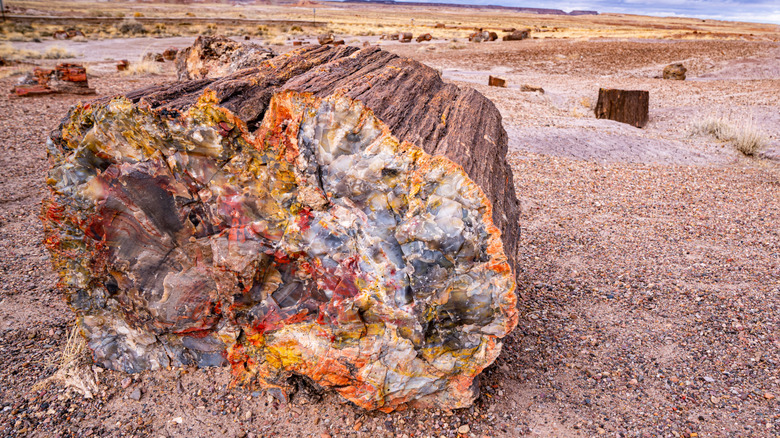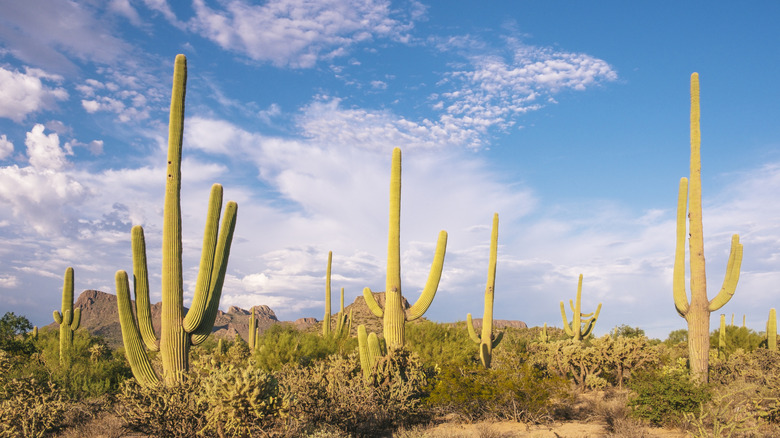4 Valuable Things Tourists Actually Stole From National Parks
The first rule of visiting the U.S. National Parks is simple: take only pictures, leave only footprints. However, over the years, some visitors have ignored that rule entirely. Theft in national parks isn't as rare as you might think. Across the country, rangers have encountered tourists stealing everything from memorial plaques and chunks of ancient redwoods to desert cacti, often leaving lasting damage to cultural and natural resources.
Federal laws exist to protect these treasures, and taking — or even damaging — archaeological sites can carry serious penalties. And this isn't just a problem for national parks. Petty theft is so common in tourist destinations worldwide that you can't even leave a towel unattended at the beach in Costa Rica. But some of the boldest thefts have happened right here in the United States. In some parks, the thefts are almost hard to believe — take Canyonlands National Park, where in 2024, two visitors brazenly targeted ancient artifacts.
Archaeological theft at Canyonlands National Park
In 2024, a couple from Colorado was arrested for stealing archaeological artifacts from Cave Spring Cowboy Camp in Utah's Canyonlands National Park. The National Park Service spent months investigating after the March 2024 robbery. Surveillance video captured a man and a woman taking nearly $1,000 worth of artifacts from a collection dating back to the 1800s, including historic harnesses. These items represent the region's early settler and cowboy culture, making their removal a significant loss for the park and its educational mission.
Authorities eventually identified the couple, Roxanne McKnight and Dusty Spencer, with the help of a tip line. The two were charged with walking on or entering archaeological or cultural resources, possessing or distributing cultural or archaeological resources, and theft of government property worth less than $1,000, per the U.S. Attorney's Office of the District of Utah. McKnight was sentenced to one year of probation and a ban from federal public lands in Utah, while Spencer received two years of probation and a similar ban. A judge also required them to pay $1,500 in restitution for the stolen items. The theft made national news, highlighting how even well-protected sites with historic artifacts remain vulnerable to visitors who ignore the rules.
The odd things tourists have stolen from the Redwoods
The Redwood National Park, an otherworldly forest full of the world's tallest trees, in Northern California, has also been a hot spot for crime. In 2024, the conservation group Save the Redwoods League was gifted several bronze sculptures honoring local wildlife, the region's ecosystem, and Indigenous heritage. Within a year, those pieces began to vanish, along with other memorial plaques honoring veterans and donors. Thieves even targeted mundane items like shower drains. According to a Facebook post by the Redwood Parks Conservancy, the string of thefts began in January 2025 and has left the nonprofit seeking $25,000 to replace what was lost. The group also warned that the stolen signage could leave visitors disoriented and wandering off-trail.
But the thefts aren't limited to markers. An underground trade in burl wood has scarred the parks' world-famous redwoods. These massive, knotted growths are prized by woodworkers for their swirling grain and can sell for thousands of dollars. Poachers have been caught climbing into the parks to cut burls straight from living trees, permanently damaging giants that have stood for centuries. One case even ended in a conviction, with the poacher receiving community service, probation, and a ban from the park. The burl poaching and plaque stealing at the Redwoods shows just how far some visitors will go for a high-value souvenir. Some tourists, though, have learned that sometimes stealing can come back to haunt them — literally.
The legend of Arizona's Petrified Forest
Petrified Forest National Park, one of Arizona's most stunning, lesser-known gems, is full of petrified wood — a fossilized quartz-like wood that dates back millions of years. A study done by Virginia Tech in 1998 found that around 12 tons of wood are removed from the park each year, a number that has likely grown since the study's publication. But it isn't the sheer amount of wood stolen that makes these thefts unique. The park has a legend stating that anyone who removes a piece of wood from the Petrified Forest will be cursed. At the museum on-site, visitors can browse letters that accompanied pieces of returned wood, detailing bad luck — everything from a plane crash to illness.
As legend goes, the only way to break the curse of stealing the ancient timber is to return it to its original resting place. Unfortunately, that can't be done because of the risk of contaminating research done within the park. Instead, the returned fossils are put in a "conscience pile" that doesn't have a known history, adding to the mystery. While the wood itself isn't inherently valuable — only reselling between 25 cents and $10 a pound — it makes sense that it would get stolen, as it is often considered beautiful and magnetic.
A spikey steal from Saguaro National Park
Finally, one of the most unusual steals comes from Saguaro National Park, also in Arizona. Back in 2018, park officials spent $3,000 to microchip 1,000 saguaro cacti, according to the Arizona Daily Star. Rangers reported the massive succulents being stolen when they found giant holes throughout the park. The mere size of the cacti is what makes these steals puzzling. Saguaros can grow up to 50 feet tall and weigh more than 12,000 pounds. While it is unknown exactly how these massive plants were taken from the park and how many, it's easy to see why, when they can resell for $100 a foot if they are in good condition. Those with arms fetch an even higher price.
But stealing from a national park, whether it's a massive saguaro or a small plaque, carries serious consequences. As these cases show, offenders can face fines, probation, bans from federal lands, or even prison time. Beyond the legal risks, theft can cause lasting damage to ecosystems and cultural sites. The National Park Service takes these crimes seriously, using patrols, surveillance, and investigations to catch thieves and safeguard the very resources that make national parks so remarkable.
